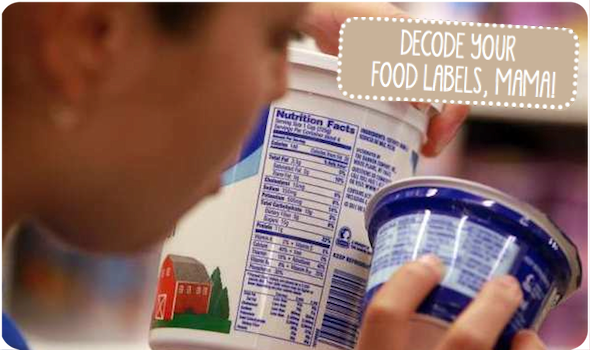
Have you ever gone to the market, turned over a box of, oh let’s say, whole grain crackers to do a quick ingredients list check, and found the nutrition label has been completely and illegibly stickered over with a white label with what appears to be similar info but in itty bitty text? Or noticed certain words on the front of a box of muesli have been crossed out by hand (?!) with what appears to be a fat black Sharpie marker? Ever wondered what’s dictating all these inconvenient obstacles to getting the facts about our food in Hong Kong?
I was wondering these same things myself and as a part of my mission to de-mystify the food shopping experience in Hong Kong I decided to dig into food label regulation here to find out what’s up and what we need to know. The Hong Kong government website for the Centre for Food Safety actually does quite a good job of explaining the rationales, but you do have to sift through FAQ’s geared toward food manufacturers and importer/exporters to get your facts. Below I’ve converted some of these facts into more consumer-speak so you have a better idea of what to make of it all next time you hit the market.
First up, I think it’s important to note that Hong Kong does adhere to nutrition labeling guidelines as recommended by the World Health Organization. That means that most likely no matter where you hail from originally, a HK food label will present the same nutrient information (namely energy in calories or kilojoules, protein, carbohydrates, total fat, saturated fatty acids, trans fatty acids, sodium, sugars, and cholesterol if present) according to a 2,000 calorie diet.
The reason there seems to be an added layer of work in stickering over existing package labels is that HK often favors the “per 100g/per 100ml” method of nutritional content over the manufacturer’s suggested “per serving.” As such, many labels aim to provide both perspectives so you can make an informed choice. Indeed, this is not always consistent and varies from product to product, but in any case it makes for one crowded little label, especially when it’s bi-lingual as well!
The line of thought behind the “per 100g/per 100ml” approach is that is allows the consumer to make an apples-to-apples comparison of two products’ nutritional value. This is probably nothing new for our friends from the UK, Europe, Australia, and other neighboring Asian countries, but in the U.S. we only know the “per serving” method. Here’s a quick primer on how it works for the uninitiated.
Let’s say we’re deciding between two brands of whole wheat crackers, Brand A and Brand B, the crackers may be cut into different shapes such that a serving of Brand A would be 7 crackers but a serving of Brand B would be 10 crackers. The reasoning goes that even though 100g may not be a realistic serving size for either cracker, you can still make an informed choice and clearly see that 100g of Brand A yields 150 calories, 5g of fat, and 10g of sugar where 100g of Brand B provides 90 calories, 3g of fat, and 0g sugar. Presumably then, an appropriate serving size of Brand B would be the healthier choice than an appropriate serving size of Brand A.
Even this logic has its faults though as, regardless, it’s still important to check the ingredients list and evaluate the presence of processed ingredients and artificial additives in both to really make the best choice. HK ingredient lists are consistent with Western standards as well in that ingredients are listed by weight from highest to lowest. The first ingredient in that list is the most present, while the last ingredient may only be in trace amounts.
I find the most confusing label combination HK offers is “per package” next to “per 100g,” but without “per serving.” “Per package” most often applies to single serving items of food, like yogurt cups, implying that one package is the suggested serving size. However, this is not always the case and I find this combination can quickly start to require some multiplication/division skills. Sometimes the package is in fact two or more reasonable serving sizes.
You should never be afraid to use your best judgment if you think the “single serving” based on the pack size is simply too much for one individual or one occasion. At that point, check the weight displayed on the front of the pack and see what it is in relation to 100g to start multiplying exactly how many kcal/kJ, grams of sugar, etc are in the whole package. That will give you a much clearer picture of how much of the pack you should portion out and how many servings are really in there.
Now, about those blacked out lines of text. Seriously, what is up with that? I always picture some dude sitting at the customs office of the HK shipping port with a lifetime supply of Sharpie markers, painstakingly crossing out health claims one-by-one. But, hey, it’s not without reason. It turns out if a foreign company sells less than a certain number of units here of a product (think about gourmet products for example, which maybe only sell in the hundreds), they are exempt from nutrition labeling. This can save the trader considerable time/money/effort/headaches.
However, that means they can’t make any nutrition claims at all on the package. It is much easier for these traders to simply cross out a claim, such as “lower sodium” or “high fibre” than it is to go through the whole process of getting the full nutrition label content approved. Not to mention, these claims may not meet HK regulations for health claims either – so best to pretend they aren’t there at all!
The final tip I have for you all is pretty much to not stress about the “NRV,” or Nutrient Reference Value, where you see it listed. The general definition of this would be the recommended daily intake of various nutrients. They are shown as percentages and based on a 2,000 calorie diet.
First of all, it is way too narrow to say we should all adhere to a 2,000 calorie diet in order to maintain a healthy weight. Everybody is different and we all find our own balance. Secondly, here in HK, the NRV is specifically calculated for people of Chinese origin. Every country has it’s own version of the NRV – in the U.S. it’s the “DV” or Daily Value whereas in Australia it’s the “DI” or Daily Intake. So, that means you would also need to check where the product was manufactured and for what market in order to determine whose recommendations these actually are!
Confusing? Yes indeedy. But I hope this has shed a little light on those little labels and, just remember, you can’t go wrong looking for foods with the most wholesome and least processed ingredients, as close to as we might find them in nature without artificial additives.
 View All
View All









 View All
View All





 View All
View All


 View All
View All









